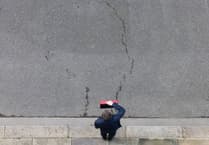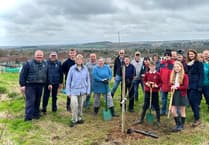Now they would like that “small active community archaeology group”, which is run by a committee headed by chairman David Quick, to grow and are seeking volunteers to join them.
Judging by their past record and the things planned for this year alone, it is an exciting time trail invitation.
Since they were formed in the early 1990s, Liss Archaeology Group projects have included working for five years uncovering the remains of a Roman village in Liss, discovered after a vicar’s wife found some Roman artefacts.
At Alice Holt, off the A325 between Bordon and Farnham, they have uncovered a Romano-British site where pottery was made and some of it was shipped, via the River Wey, to London.
They also found a brick kiln for making roof tiles.
Before that, Neanderthal and Iron Age man made their homes there.
At Idsworth Church, built near Petersfield in 1033, the group have found pieces of Roman pottery in the fields around and at Blackdown, near Haslemere, there are Neolithic pits and it is possible there was a settlement there.
At Whitehill, excavation of the barrows has revealed bronze Iron Age weaponry.
Juliet Smith, archaeological director for Liss Archaeology Group, has worked on these sites and one of the most exciting is the excavations at Colemore, near Alton, where they have been working for nine years to uncover the remains of a villa – not that of a rich Roman general but probably owned by a farmer.
Said Juliet: “Although we are calling it a villa, it probably was more of a farmhouse built under Roman orders. Under Roman rule, people had to build proper structures such as the villa at Colemore and if they didn’t obey they would lose their land and be sold as slaves.”
An artist’s impression of how the villa or farmhouse would have looked it is impressive with its colourful brickwork.
Still on the subject of Roman villas, she added: “We are still trying to trace a lead coffin found when an excavation of a Roman village at Stroud took place in 1905.”
This shows the diversity of the work of the group and Juliet has been their main stay bringing her considerable knowledge to projects they are working on.
Ancient sites and people have filled her life from an early age and, after graduating from Surrey University, she became a professional archaeologist.
Sadly, ill health forced her to give up and now she works as a volunteer for Liss Archaeology Group, but also takes on a few paid commissions.
A mum of three, Juliet lives with her partner in Hindhead and manages to combine a busy family life with archaeology administration work or going to digs, which can mean camping on site for several days regardless of the weather, although heavy snow does bring things to a halt.
She said: “When I first started out I was told there were no traces of Romans in Surrey, and Hampshire and I think we have proven that wrong. We have also found evidence of Iron Age people and Celts who occupied the two counties for hundreds of years.”
This year, the group will be back at Colemore in the summer and then, weather and the site’s harvest programme permitting, in the autumn.
In the course of the excavations, Liss Archaeology Group has sunk 50 test pits around the site and found a water-management system from that time still working.
Working at Colemore is just one of the many things planned for the year ahead. At the beginning of March, there will be geophysicists at Idsworth to complete the survey around the church. There will also be some indoor work marking up and processing the finds from the excavations.
A Roman glass day school is due to take place on March 10, from 9.45am-3pm at St Mary’s Church, Liss, when one of the UK’s leading experts, Dr Denise Allen, will take the class through glass processes and forms from the Romano-British period with modern replica examples and some of the group’s own finds from Colemore.
In April, there is a social outing to Avebury.
“It’s one of my favourite sites,” said Juliet, “and our very own retired professional archaeologist and college lecturer, Pete Price, has kindly agreed to give us a tour of England’s’ largest stone circle complex and associated monuments.”
Field walking and excavation are due to take place at Stroud in August, plus more excavation work at Colemore.
Last November, 15 Liss Archaeology Group members attended a successful drawing day school, and David Hopkins, the Hampshire cunty archaeologist, gave a day of tuition in the archaeological skill of scale drawings for publication and reports.
Juliet said: “An important part of any excavation, the drawings help to illustrate the artefacts unearthed and allow a pictorial comparison between sites.
“Most excavation reports have sections of pottery types complete with each form having a drawing.
“From our Colemore excavations, we have many rims and bases waiting to be drawn for the eventual formal report. We would like to hold a series of drawing days to make a start.
“We just need a free or cheap venue to use once or twice a month for a few hours at a time. If anyone can offer us a room with a table, that would be a huge help.”
New members, who will have the opportunity to help as volunteers, are being sought for two weekends of both magnetometry and resistivity at Colemore.
Also, ahead of the dig in April, the group want to extend the high resistance survey to cover areas that they can consider for this year’s trenches.
“All are welcome” said Juliet, “and there will be some training for beginners.”
She added “We are still looking for more finds processors. Finds processing can be combined with digging, help is generally needed after morning tea break when the previous days finds have had initial work completed.
“The first part of the day is very busy for the finds team leaders who have various tasks to complete before the processing proper can start.
“Once new finds processors are fully trained, they may be asked to help out with start-of-day activities.
“We are also looking for more people to train as supervisors and recorders at the trenches. There is a huge workload which needs to be shared to take the pressure off the small team.”
If you would like to help or to find out more about Liss Archaeological Group, e-mail [email protected] or visit lissarchaeology.uk.



